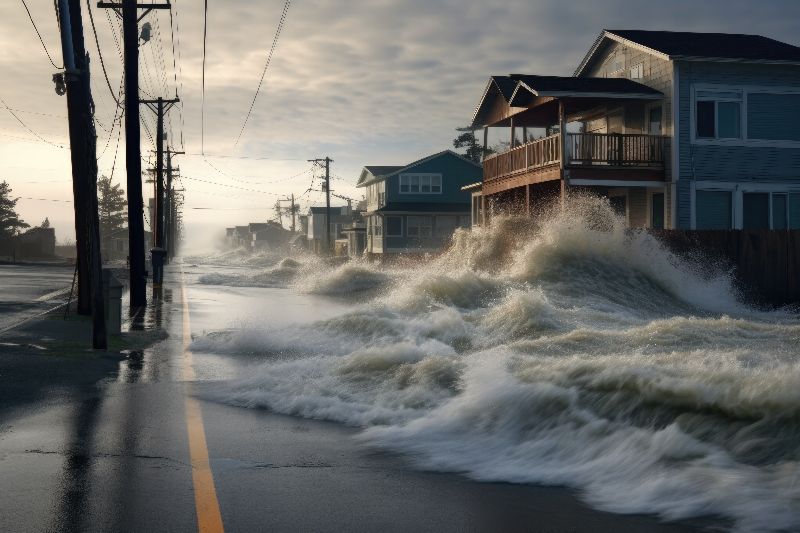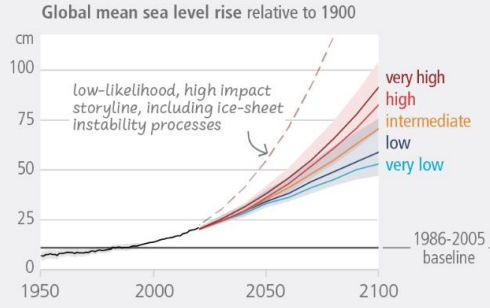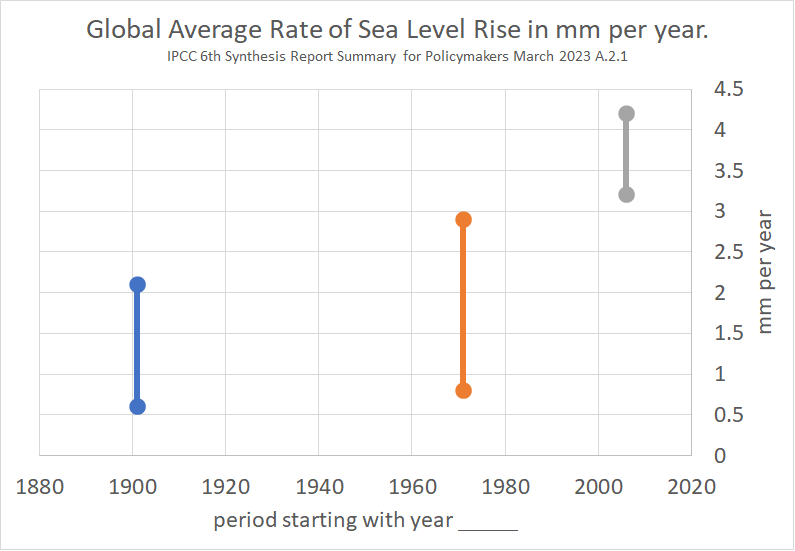Sea Levels Are Rising Faster and Faster, Portending More Flooding in Mass. – Still Time to Avoid Disaster
. Posted in News - 0 Comments
By Eric Weld, MassLandlords, Inc.
Almost everywhere on earth, certainly including Massachusetts, ocean levels are rising faster than predicted, and their rise is accelerating. All along the U.S. eastern seaboard, sea level increases have significantly picked up pace in recent years, now surpassing projections.

Seaside homes like these will become increasingly unviable as investments (or dwellings) as ocean levels, in Massachusetts and worldwide, continue to rise at an accelerating and perilous pace in coming years. Image: cc by-sa 123rf.
Alongside rising sea levels, flooding from rain, river, storm surge or a combination of all three is a risk for 321,487 Massachusetts properties, according to First Street Foundation (FSF), a nonprofit that charts flood risk for property owners. Many waterfront properties in Boston have a 90% chance of being flooded with at least 12 inches of water during the next five years, according to FSF projections. (We recommend that you check your property’s flood risk, soon, using their assessment tool.)
While stormwaters may recede, sea level is more or less permanent. The Massachusetts coast is home to more than 5 million people, some 75% of the state’s population, according to the National Oceanic and Atmospheric Administration (NOAA). Tens of thousands of properties in Massachusetts’ coastal communities are vulnerable to rising seas and tidal flooding.
Boston lies in a shoreline zone at severe or extreme risk of flooding. The sea level around Boston is rising about 1 inch every eight years, but that statistic doesn’t speak to the urgency of the situation, because the rate of rise is quickening at a rapid pace. It’s impossible to predict the exact amount of sea level rise within a couple decades, but the range of possibilities is very well studied and understood: sea levels globally will rise by somewhere between 1.5 feet and dozens of feet if we don’t get more serious about controlling climate change. We could see countless properties permanently under water within our lifetime (not to mention “under water” financially).
All this accelerating sea level rise is being directly caused by melting glaciers in Antarctica and Greenland, home to most of the earth’s glaciers. The world’s glaciers are rapidly melting, and increasingly so, because the emission of greenhouse gases and carbon dioxide from human activity since the beginning of the Industrial Age is raising the earth’s temperature. Higher temperatures in Antarctica and Greenland result in ice melting at a pace faster than humans have ever seen.

The IPCC forecasts for sea level rise in centimeters must be read carefully. The graphs show sea level rise is accelerating upward. There are various scenarios plotted in terms of total emissions from “very low” emissions, meaning drastic and unimaginably fast cuts to greenhouse gas emissions, from “very high” emissions, meaning slow but eventual cuts to emissions. Which line are we on? We are on none of these, likely somewhere above very high, because current policy has emissions holding steady, not decreasing. See graph showing current policies. Editorial use IPCC Climate Change 2023 (6th Synthesis Report) Summary for Policymakers, Page 17, figure SPM.4c left. Original IPCC Caption: Global mean sea level change in centimetres, relative to 1900. The historical changes (black) are observed by tide gauges before 1992 and altimeters afterwards. The future changes to 2100 (coloured lines and shading) are assessed consistently with observational constraints based on emulation of CMIP, ice-sheet, and glacier models, and likely ranges are shown for SSP1-2.6 and SSP3-7.0.
Increasing Climate Change Action
At our current level of global efforts to curb climate change, fossil fuel emissions are predicted to hold steady (i.e., still too high, but not getting worse). That in itself is an achievement, especially considering widespread political and popular resistance to any global warming mitigation measures. Unfortunately, our current policies are not nearly enough to limit sea level rise to a manageable level.
Even if we could slowly reduce our emissions over the next decade or so, global sea levels would rise another 100 centimeters (nearly 40 inches, or 3 ½ feet), according to the latest report by the International Panel on Climate Change (IPCC). We could reduce that statistic to 50 centimeters (20 inches, or 1 ½ feet) if we were to miraculously and immediately cut emissions to a “very low” rate. Highly unlikely. These estimates are for 2100, but 2100 is not the end of sea level rise. Long-term, the situation is untenable.
As it stands, with our high level of emissions remaining constant, sea level rise accelerates beyond IPCC charts, to who knows where? 5 feet? 10 feet? More? All this will happen while transient storms get increasingly worse. If your property has been flooded once already, that is a harbinger of more to come.
Global Efforts
Humans are innovative, creative beings, capable of succeeding in our collective effort to overcome the worst effects of climate change and sea level rise, if we have the will. At the moment, we are engaged in an historic global effort, on many fronts, to mitigate the effects of rising sea levels on human life and habitation.
Locally, Climate Ready Boston is a comprehensive plan to protect the metropolitan area from sea level rise, storm flooding and warming temperatures. The plan includes efforts to protect waterfront areas from flooding caused by sea level rise and intensifying storm activity. Some projects have already been completed, including seawalls, elevated walkways and green spaces in Dorchester, South Boston, downtown and elsewhere.
Other coastal areas around the world, such as Louisiana and parts of Florida, are constructing massive levees, but also shaping new mangrove and seagrass growth areas, cultivating coral reefs and building dunes and barrier islands to help absorb higher water levels and storm surge.
And because sea level rise is primarily caused by climate change, efforts to minimize it are also incorporated into plans to combat temperature increases. Any initiative that helps reduce global warming will also assist in preserving glaciers and mitigating sea level rise. Toward the top of that list is moving away from fossil fuel combustion and toward more efficient, and less-polluting, energy sources.

This MassLandlords graph of IPCC data shows the rate of sea level rise in millimeters per year over time. The vertical lines show bands of uncertainty. Because the gray band corresponding to the 2010s does not overlap the blue band corresponding to the 1900s, we have very high confidence that sea level rise is accelerating. Original IPCC Caption: Global mean sea level increased by 0.20 [0.15 to 0.25] m between 1901 and 2018. The average rate of sea level rise was 1.3 [0.6 to 2.1] mm yr-1 between 1901 and 1971, increasing to 1.9 [0.8 to 2.9] mm yr-1 between 1971 and 2006, and further increasing to 3.7 [3.2 to 4.2] mm yr-1 between 2006 and 2018 (high confidence). Human influence was very likely the main driver of these increases since at least 1971.
Making Slow Progress…
Millions of residential and commercial property owners are making transitions to clean and renewable energy systems. Electric vehicle sales are quickly expanding, with more than 10 million sold in 2022 and an expected 14 million in 2023. EV sales alone are expected to reduce the need for 5 million barrels of oil a day by 2030.
For the first time, in 2022, heat pump sales surpassed gas furnace sales. And solar panel capacity increased 47% year over year from Q1 2022 to Q1 2023, according to the Solar Energy Industries Association.
Our collective efforts to reduce greenhouse gas emissions may be making inroads. While global temperatures are expected to continue to rise, the most recent IPCC report notes that we still have time to contain the worst effects. At present, global average temperatures are projected to rise 1.5 degrees Celsius (2.7 degrees Fahrenheit) by the 2030s. That global rise will carry multiple catastrophic side effects, including larger, longer and more intense storms and hurricanes, droughts leading to more widespread and rampant wildfires, and massive flooding with increased rains and sea level rise because of glacial melting.
Still, we are at a vital crossroads in our global fight to protect humans against climate change, notes the IPCC report. If we can halve our fossil fuel emissions by around 2030, and realize net-zero emissions by 2050, a consensus of scientists agrees that we can manage the increasing temperatures without extinction-level catastrophe.
…But Not Enough
While we may be making progress against climate change, it’s not nearly enough, nor fast enough. Globally, we waited too long to start taking meaningful action as climate change forces have gained steam. Even in 2022, humans worldwide set an ignominious record of 36.8 gigatons, the highest-ever recorded emissions of carbon dioxide from fuel energy combustion.
Even if, as we hope, we can hold the line of global average temperature rise at 1.5 degrees Celsius, extreme weather events are already baked in at the current level, and will likely be the norm for decades to come.
This means that sea level rise is highly likely to continue and increase, to the point of shifting waterfronts further inland. Some areas that are livable and buildable now will be submerged or frequently flooded within the coming years and decades absent extraordinary infrastructure investment.
What Can Landlords Do?
To be clear, no individual person’s actions will be enough to stop climate change. We must have coordinated public policy. But as property owners and housing providers, our businesses are rife with energy-using appliances and devices that, in many cases, contribute to global warming. Therefore, opportunities abound for us to convert to energy-efficient, non-polluting households, and to join global efforts to limit warming and its deleterious effects. At the very least, these individual actions reduce our exposure to what may become increasingly fast policy and climate changes. Our Landlord’s Guide to Reducing Greenhouse Gas Emissions in Rental Properties goes into detail.
In addition to emissions reductions, tackle flood risk head-on. Property investment strategies will have to change, or move, as coastlines recede. Divesting from real estate along coasts, beside rivers and in low-lying valleys, where flood factors are high, will be essential. In fact, many current riverfront and oceanfront properties in Massachusetts are no longer dependable investments to consider in the first place. If you realize this before most others, you can stay ahead.
For your existing properties, think about water management. Invest in large, commercial gutters and route the spouts into dry wells or far away from your built structures, to deflect potential flooding. Consider regrading lots to direct runoff away from buildings. Construct berms to deflect water that might come in from the street.
As a late line of flooding defense, you might consider building sandbag walls around critical systems like floor-mounted basement boilers. This might seem absurd to someone with a dry basement, but many of us are already aware of stormwater in our basements, and for us, this is something to consider. Better yet, move your heating systems up and away from low areas, and don’t locate them in low-lying areas in new construction. Best of all, convert to mini-split heat pumps, which can be mounted on walls in upper floors, and even roofs, far away from flooding danger.
(A large-scale lesson in power systems placement: In 2011, the Fukushima Daiichi nuclear power plant, in coastal Fukushima, Japan, became a deadly disaster partly because its emergency power generators in the basement levels were flooded by a tsunami triggered by an earthquake off the coast. The loss of the generators meant the loss of cooling capability, which led to three nuclear meltdowns, hydrogen explosions and the widespread release of radiation for miles around Fukushima.)
Considering Managed Retreat
We should all do all we can to minimize our respective carbon footprints. Without individual action, we will never realize our zero-emission goals. However, while we do so, we also have to acknowledge that not everyone is able or willing to change their polluting behaviors any time soon. Lack of political will, economics and budgetary limitations, along with misinformation and sheer laziness, all combine to foil our collective efforts to reduce fossil fuel emissions.
Sea level rise and flooding are already inevitable, and it’s impossible to predict how severe it will get. Therefore, getting out of the way of flooding will be a vital strategic component.
Managed retreat is a relatively new idea that is gaining familiarity among threatened coastal communities. It is the concept of migrating people away from areas that are threatened by changing natural forces, such as sea level rise. Managed retreat, as a policy, attempts to strategically manage mass migrations, for example, away from shifting coasts. The policy may include campaigns to discourage or control property purchases and development in threatened areas; government buy-outs of endangered properties; restoration of natural habitats; and enforcing no-build zones.
Managed retreat, while controversial now, will likely become a more recognized policy as sea levels rise in coming years, rendering some coastal areas – such as those in Massachusetts – unlivable.
Acknowledging this reality, MassLandlords has proposed a bill to establish a Climate Resilient Capital Task Force. The task force would project impacts of climate change and sea level rise around Boston to determine the most prudent actions for protecting state government infrastructure in the case of massive flooding. As part of the solution, the task force would consider relocating state government offices to a more climate-secure region, likely further inland.
In projections by IPCC, NOAA and other agencies, it’s likely that commercial, government and residential property owners near threatened coasts will have no choice but to consider managed retreat during this century.
More of the Same, Except Faster
We are now at a collective decision point. If we can continue to build on our efforts to contain climate change – eradicating fuel emissions by 2050 – we may be able to hold the line at 1.5 degrees Celsius.
However, if we fail in our collective efforts, and allow global average temperature to rise 2 or more degrees Celsius, we will likely enter dangerously unpredictable territory that will detrimentally affect the lives of everyone on earth. Storms, flooding, droughts, wildfires, and severe hot and cold shifts will increase to life-threatening levels on an ongoing schedule. Large-scale failures of governmental and social services would become a likelihood as water and food supplies dwindle, as populations of plant and animal species that we rely on are threatened, and as climate refugees enter Massachusetts seeking better opportunity. Air quality will deteriorate from both extreme heat and widespread wildfire ash and particulates. Civil conflict may increase as supplies and delivery systems of life resources fall behind demand.
The good news is, we humans have the knowledge, ability and wherewithal to slow or even stop glacial melting and contain sea level rise to livable levels. But time is not on our side, and our current pace isn’t adequate to the task. Converting away from fossil fuel-burning heating and cooling systems and cars, and toward electric, non-polluting systems and vehicles, is an urgent imperative if we are to avoid mass disasters. Planning and moving built environments away from fast-receding coastal areas must become part of our strategic, long-term outlook.
Impressively, we are on the right track in mitigating effects of climate change, despite political and popular resistance. By the millions, we are making untold individual changes that will literally save lives.
We just need to pick up the pace.




